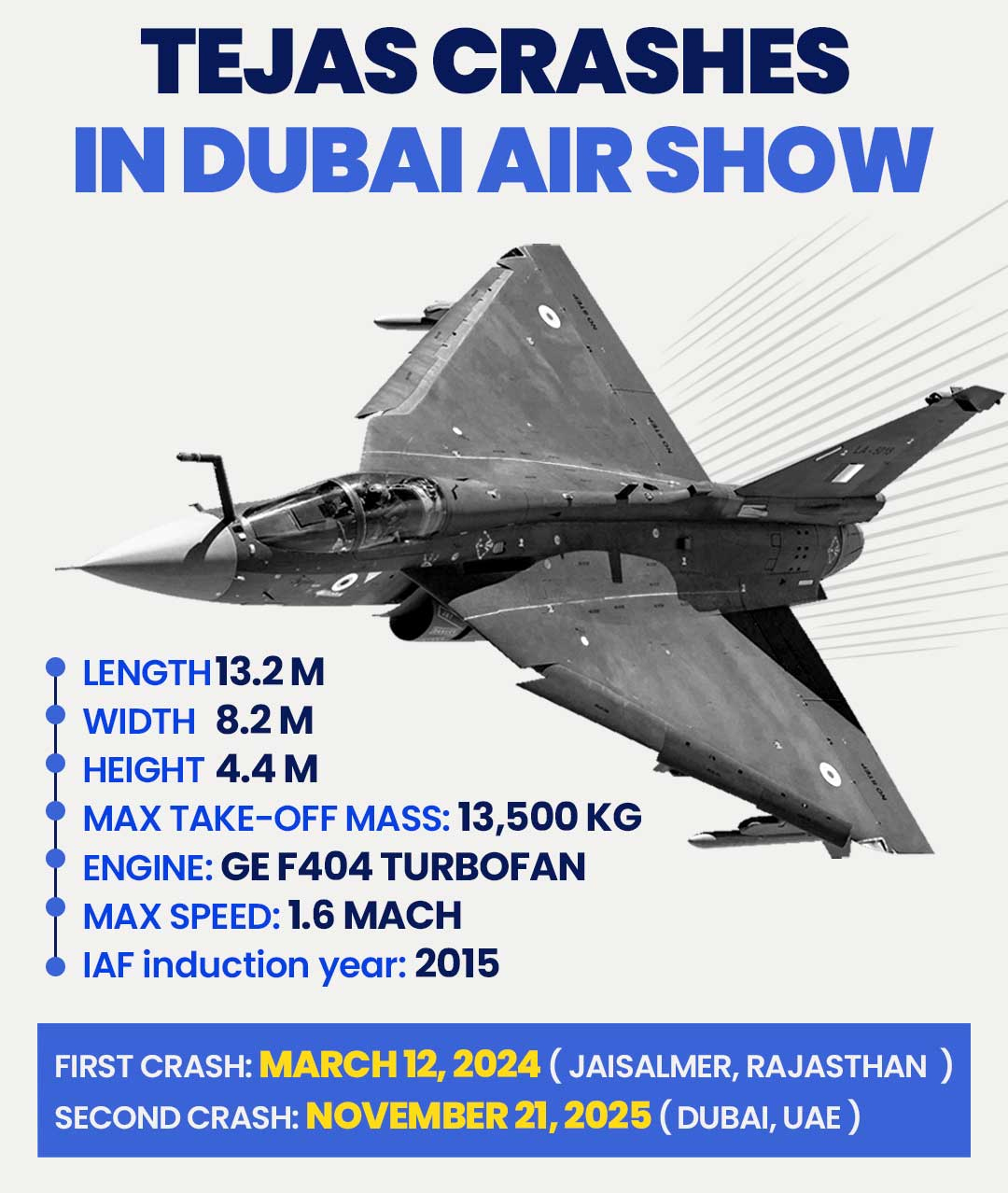Context:
An Indian HAL Tejas light combat aircraft recently crashed during a demonstration flight at the Dubai Air Show, held at Al Maktoum International Airport. Wing Commander Naman Syal, the 34-year-old pilot, sustained fatal injuries and succumbed to death.
Strategic & Defence Implications of the crash:
-
-
- Symbolic setback for ‘Make in India’: Tejas is a flagship indigenous fighter; a crash during an international display affects perception.
- Safety & Operational Review: The IAF may revise protocols for aerobatic displays and demonstration flights.
- Impact on Export Prospects: Tejas has been promoted internationally; such accidents may influence export interest.
- Symbolic setback for ‘Make in India’: Tejas is a flagship indigenous fighter; a crash during an international display affects perception.
-
About Tejas:
-
-
- Tejas is an indigenous, 4.5-generation, multi-role fighter aircraft developed in India by the Aeronautical Development Agency (ADA) and manufactured by Hindustan Aeronautics Limited (HAL).
- It is designed for offensive air support, close combat, and ground attack, and entered service with the Indian Air Force (IAF) in 2016.
- The project began in the 1980s to replace the aging MiG-21 fleet.
- First flight: 4 January 2001.
- Inducted into the Indian Air Force (IAF): 2015 (Tejas Mk1)
- First flight: 4 January 2001.
- Tejas is an indigenous, 4.5-generation, multi-role fighter aircraft developed in India by the Aeronautical Development Agency (ADA) and manufactured by Hindustan Aeronautics Limited (HAL).
-
Variants of Tejas:
-
-
- Tejas Mk1
- The original production variant.
- Moderate indigenous content; used by IAF.
- The original production variant.
- Tejas Mk1A
- Modernized version → ~40+ improvements over Mk1.
- Enhanced radar (AESA), EW suite, mid-air refueling, more indigenous components.
- Modernized version → ~40+ improvements over Mk1.
- Tejas Mk2 (Medium Weight Fighter)
- Under development.
- Larger airframe, canard–delta design, more powerful engine, new sensors.
- Under development.
- Trainer / Naval Variants
- There are two-seat trainer versions.
- Naval variant (for aircraft carrier operations) is being developed / tested.
- There are two-seat trainer versions.
- Tejas Mk1
-
Operational Role & Significance:
-
-
- Multirole capability: Tejas is designed for air superiority, ground‑attack, and reconnaissance missions.
- Defense Self-Reliance: Tejas is a flagship project for India’s “Make in India” / Atmanirbhar Bharat ambition in aerospace & defense.
- Force Modernization: Replacing aging MiG-21s and bolstering squadron numbers.
- Export Potential: As production scales and costs drop, Tejas could appeal to other countries looking for a light multirole fighter.
- In 2025, India approved a major order for 97 more Tejas Mk1A jets (~₹62,000 crore) to boost indigenous fleet strength.
- Multirole capability: Tejas is designed for air superiority, ground‑attack, and reconnaissance missions.
-
Conclusion:
The Tejas crash is a tragic event with human, strategic, and reputational costs. While honouring the pilot and investigating the cause, India must ensure robust safety, operational protocols, and confidence in indigenous defence platforms.







